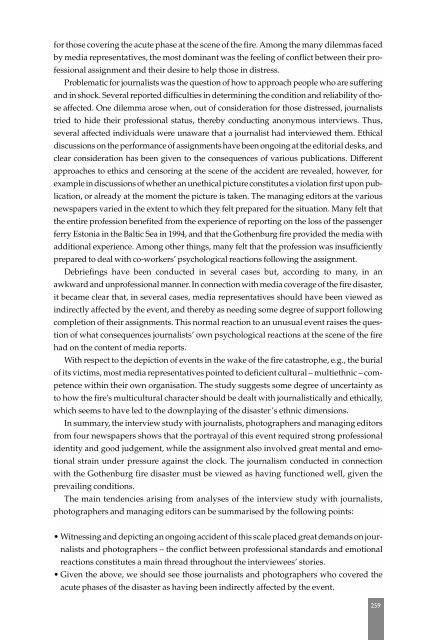Göteborgsbranden 1998 - Myndigheten för samhällsskydd och ...
Göteborgsbranden 1998 - Myndigheten för samhällsskydd och ...
Göteborgsbranden 1998 - Myndigheten för samhällsskydd och ...
You also want an ePaper? Increase the reach of your titles
YUMPU automatically turns print PDFs into web optimized ePapers that Google loves.
for those covering the acute phase at the scene of the fire. Among the many dilemmas faced<br />
by media representatives, the most dominant was the feeling of conflict between their professional<br />
assignment and their desire to help those in distress.<br />
Problematic for journalists was the question of how to approach people who are suffering<br />
and in shock. Several reported difficulties in determining the condition and reliability of those<br />
affected. One dilemma arose when, out of consideration for those distressed, journalists<br />
tried to hide their professional status, thereby conducting anonymous interviews. Thus,<br />
several affected individuals were unaware that a journalist had interviewed them. Ethical<br />
discussions on the performance of assignments have been ongoing at the editorial desks, and<br />
clear consideration has been given to the consequences of various publications. Different<br />
approaches to ethics and censoring at the scene of the accident are revealed, however, for<br />
example in discussions of whether an unethical picture constitutes a violation first upon publication,<br />
or already at the moment the picture is taken. The managing editors at the various<br />
newspapers varied in the extent to which they felt prepared for the situation. Many felt that<br />
the entire profession benefited from the experience of reporting on the loss of the passenger<br />
ferry Estonia in the Baltic Sea in 1994, and that the Gothenburg fire provided the media with<br />
additional experience. Among other things, many felt that the profession was insufficiently<br />
prepared to deal with co-workers’ psychological reactions following the assignment.<br />
Debriefings have been conducted in several cases but, according to many, in an<br />
awkward and unprofessional manner. In connection with media coverage of the fire disaster,<br />
it became clear that, in several cases, media representatives should have been viewed as<br />
indirectly affected by the event, and thereby as needing some degree of support following<br />
completion of their assignments. This normal reaction to an unusual event raises the question<br />
of what consequences journalists’ own psychological reactions at the scene of the fire<br />
had on the content of media reports.<br />
With respect to the depiction of events in the wake of the fire catastrophe, e.g., the burial<br />
of its victims, most media representatives pointed to deficient cultural – multiethnic – competence<br />
within their own organisation. The study suggests some degree of uncertainty as<br />
to how the fire's multicultural character should be dealt with journalistically and ethically,<br />
which seems to have led to the downplaying of the disaster’s ethnic dimensions.<br />
In summary, the interview study with journalists, photographers and managing editors<br />
from four newspapers shows that the portrayal of this event required strong professional<br />
identity and good judgement, while the assignment also involved great mental and emotional<br />
strain under pressure against the clock. The journalism conducted in connection<br />
with the Gothenburg fire disaster must be viewed as having functioned well, given the<br />
prevailing conditions.<br />
The main tendencies arising from analyses of the interview study with journalists,<br />
photographers and managing editors can be summarised by the following points:<br />
• Witnessing and depicting an ongoing accident of this scale placed great demands on journalists<br />
and photographers – the conflict between professional standards and emotional<br />
reactions constitutes a main thread throughout the interviewees’ stories.<br />
• Given the above, we should see those journalists and photographers who covered the<br />
acute phases of the disaster as having been indirectly affected by the event.<br />
259

















